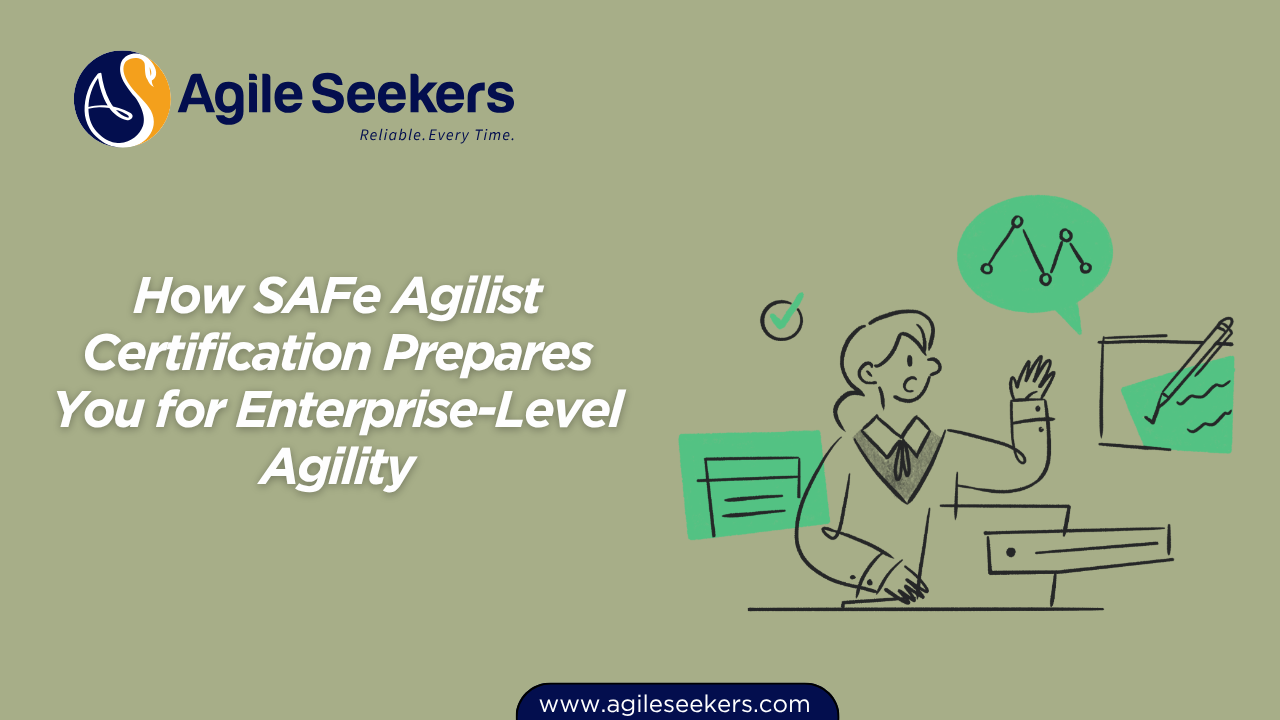How SAFe Agilist Certification Prepares You for Enterprise-Level Agility

Enterprise agility goes beyond having a few agile teams. It’s about creating alignment, adaptability, and speed across the entire organization. The SAFe Agilist Certification (earned through the Leading SAFe course) equips you with the knowledge and mindset to lead this transformation. Let’s break down how it prepares you to drive agility at scale.
What enterprise-level agility really means
Enterprise agility is the ability of an organization to respond quickly to market changes, customer demands, and new opportunities—across multiple teams, portfolios, and business units. It requires:
-
Strategy and execution working in sync
-
Cross-team collaboration without silos
-
Decentralized decision-making
-
Continuous improvement through feedback
Without a framework, agile often remains stuck at the team level. That’s where SAFe (Scaled Agile Framework) comes in, and why the SAFe Agilist role is essential.
1. Building a shared language across the enterprise
Scaling agility breaks down when different departments use different terms and approaches. The SAFe Agilist Certification helps you adopt a consistent vocabulary—terms like Value Stream, Agile Release Train (ART), Program Increment (PI), and Lean Portfolio Management.
This shared understanding ensures that leaders, managers, and teams stay aligned, reducing confusion and streamlining collaboration.
2. Aligning strategy with execution
One of the core benefits of the certification is learning how to bridge the gap between high-level business strategy and team-level delivery. You’ll understand how portfolios, programs, and teams connect through value streams, and how objectives guide priorities.
As a certified Agilist, you’ll be able to ensure the right initiatives get funded, dependencies are managed, and business goals translate into tangible outcomes.
3. Organizing around value, not silos
Traditional organizations group teams by function, leading to handoffs and slow delivery. SAFe encourages organizing around value streams—the flow of work from idea to customer.
The certification equips you to identify value streams, restructure work around them, and drive faster delivery of customer value.
4. Leading Agile Release Trains (ARTs)
The Agile Release Train is SAFe’s way of aligning multiple teams to plan and deliver together. As a SAFe Agilist, you’ll learn how ARTs operate, how Program Increment planning works, and how to keep teams moving in the same direction.
This knowledge is crucial if you’re guiding large-scale initiatives where coordination across dozens or even hundreds of people is required.
5. Developing lean-agile leadership
Agility isn’t only about processes—it’s about leadership style. The SAFe Agilist Certification emphasizes lean-agile leadership, where leaders empower teams, decentralize decisions, and encourage a culture of learning.
This mindset shift helps you foster trust, autonomy, and innovation, which are critical for true enterprise agility.
6. Improving portfolio-level decision-making
At scale, deciding what to fund and where to allocate resources becomes complex. The certification teaches you Lean Portfolio Management, which helps leaders prioritize investments, create guardrails, and adapt funding as priorities shift.
With this skill set, you can help your organization stop overcommitting and focus on delivering maximum value.
7. Embedding transparency and feedback loops
Enterprise agility depends on continuous learning. SAFe embeds Inspect & Adapt events, system demos, and regular metrics reviews to create feedback loops.
As a SAFe Agilist, you’ll learn how to use these practices to bring transparency, spot issues early, and course-correct before small problems escalate.
8. Increasing credibility and influence
Certification is more than a credential. It signals that you understand how to apply agile at scale, giving you credibility when leading change. It also connects you to a community of practitioners who are continuously improving how SAFe is applied in different industries.
This recognition often opens doors for leadership opportunities and transformation roles.
9. Understanding challenges and avoiding pitfalls
The SAFe Agilist Certification also prepares you to approach scaling with realistic expectations. You’ll understand potential pitfalls, like over-engineering processes or treating SAFe as a rigid set of rules, and learn how to avoid them.
This balanced perspective allows you to guide transformation in a way that’s both structured and flexible.
10. A foundation for advanced SAFe roles
The certification is a starting point. Once you’re certified, you can explore advanced paths such as SAFe Scrum Master, SAFe POPM, SAFe Advanced Scrum Master, or SAFe Release Train Engineer. Each role deepens your expertise and expands your ability to support enterprise agility.
For many professionals, the Leading SAFe® Agilist Certification Training is the natural entry point into this journey.
Conclusion
The SAFe Agilist Certification gives you far more than a title—it prepares you to lead transformation across teams, portfolios, and the enterprise. It provides the mindset, tools, and structure to align strategy with execution, build flow through value streams, lead at scale, and embed continuous learning into the system.
If your goal is to influence change and help your organization achieve agility at scale, starting with the Leading SAFe Agilist Certification Training is the right step.
Also read - The Role of a SAFe Agilist in Driving Lean Portfolio Management




















